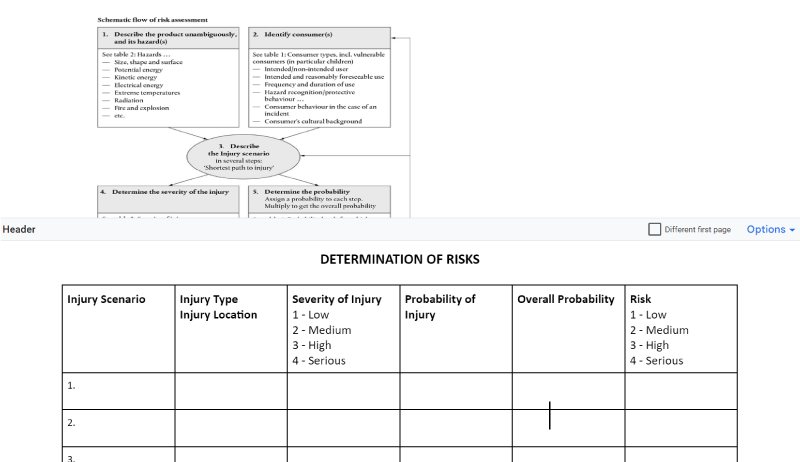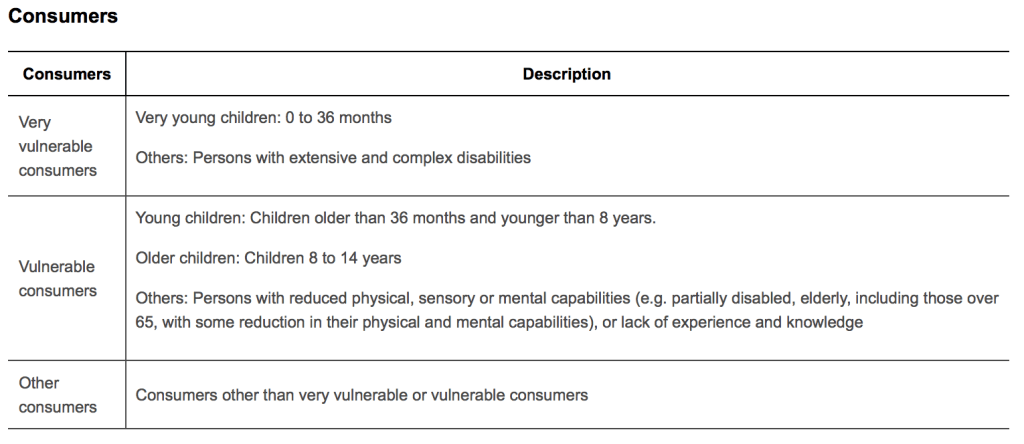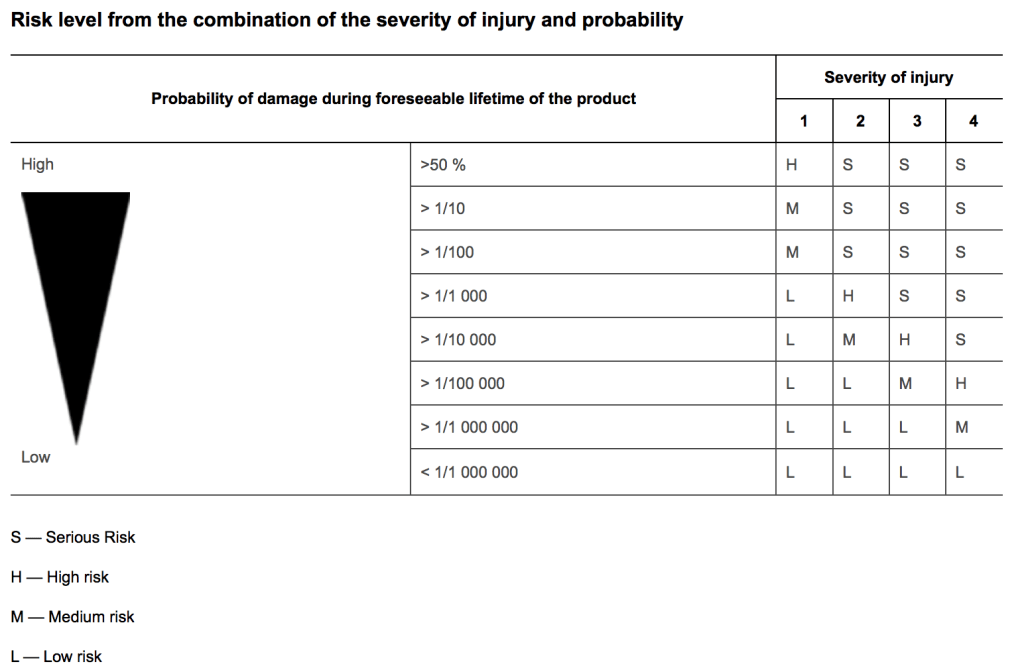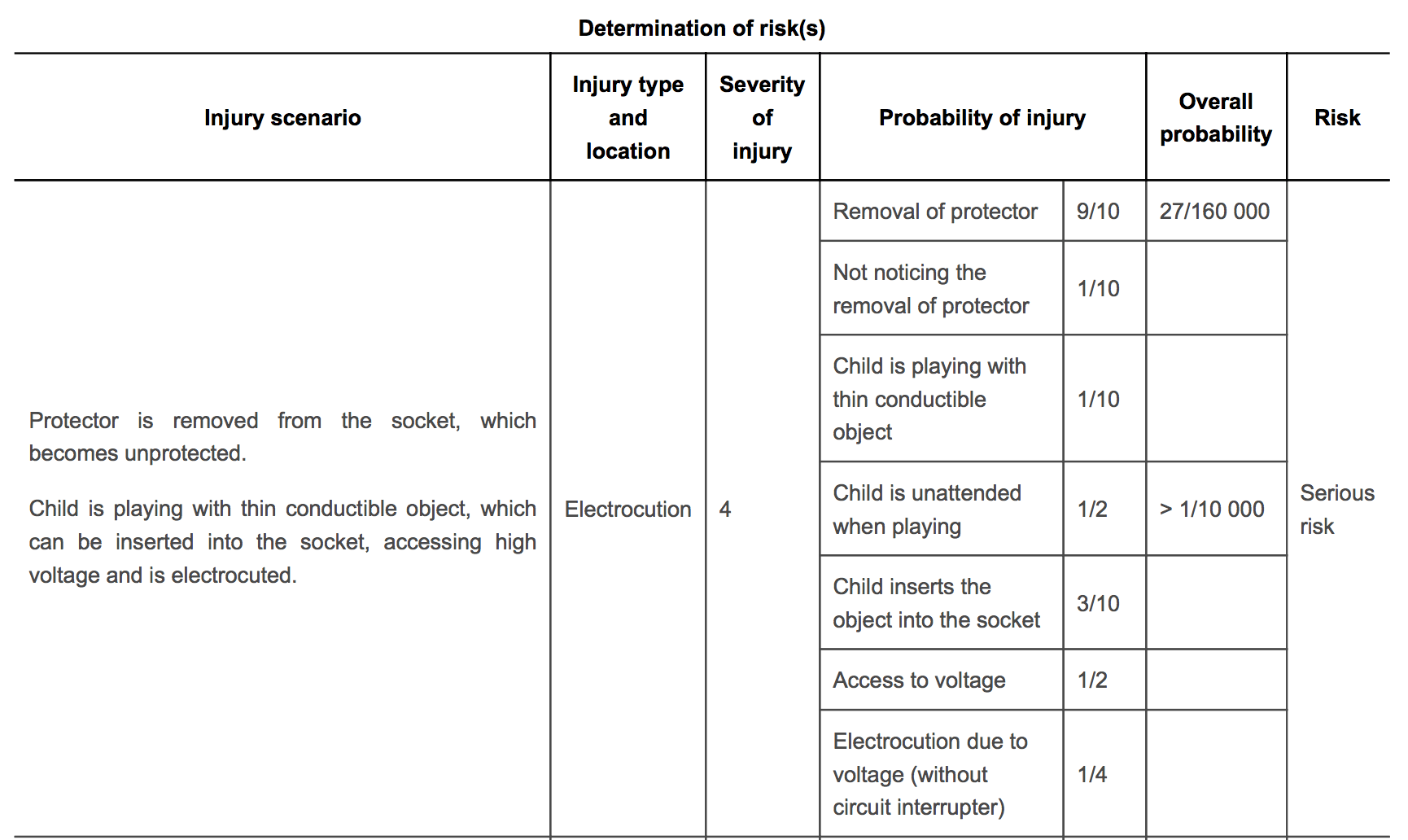We are an award winning product design consultancy, we design connected products and instruments for pioneering technology companies.
A product risk assessment template to help you identify safety hazards
Reading time 10 mins
Key Points
- Conducting regular product risk assessments is crucial for identifying, reducing, and resolving safety hazards
- Documented product risk assessments are mandatory to meet compliance requirements and help to strengthen brand identity and integrity
- Risk is defined as something that threatens the health or even the lives of people or animals or that may cause considerable material damage to the environment
- Risk can be determined by: anticipating injury or hazardous scenarios, determining the probability of occurrence, and combining the severity of the injury/hazard with the probability of occurrence to obtain the overall risk factor
- Risk factors are grouped into 4 categories: low, medium, high, and serious
- Once the risk factors have been identified, action can be taken to address them and ensure product safety standards are high and that every effort has been made to keep users safe
Ready to start developing your new product?
Call us for a quote!
Ben Mazur
Managing Director
I hope you enjoy reading this post.
If you would like us to develop your next product for you, click here
All products carry a certain level of intrinsic risk: we take care when climbing up ladders, working with drills, or even opening cans. However, product developers and manufacturers are still responsible for ensuring that potential risks and the likelihood of occurrence are identified and that steps are taken to eliminate hazards or control them. Our product risk assessment template will help you to:
- Document and list the potential safety hazards of your product
- Identify target users and analyse the user characteristics that could cause harm
- Analyse the design, structure, materials, packaging, and other properties of the product
- Identify hazards/harm to humans, animals, and the environment that might be caused by the products (e.g. mechanical, biological, chemical, or electrical hazards)
- Identify and comply with any legislation, harmonised standards, or legal requirements
- Assess the likelihood of the hazard or harm’s occurrence
- Manage and reduce the likelihood of occurrence
Doing so will improve your product and meet legal or regulatory requirements. Better still, by developing products that are safe, and that customers know they can trust, your brand identity and integrity will be strengthened. Lastly, you won’t run the risk of product recalls, returns, or the negative consequences brought on by products causing harm.
 Product Risk Assessment
Product Risk Assessment
Download our free template
What constitutes a risk, and is an assessment mandatory?
UK Legislation defines risk as “something that threatens the health or even the lives of people or animals, or that may cause considerable material damage to the environment.” Risk can be determined in three steps:
- Anticipate an injury scenario in which the intrinsic product hazard harms the consumer, and determine how severe that harm could be. Legislative guidelines propose 4 levels of severity based on the resulting injury or consequence: (1) low risk – basic first aid treatment and no doctor required; (2) medium risk – A&E visit and no hospitalisation required; (3) high risk – hospitalisation required that could lead to a permanent loss of function; (4) serious risk – consequences that affect reproduction or offspring, disability, loss of limbs, brain damage, or fatal injury.
- Determine the probability of the consumer being injured by the intrinsic hazard of the product. The probability can be expressed as a fraction, such as ‘> 50 %’ or ‘> 1/1 000.’
- Combine the hazard (in terms of severity of the injury) with the probability (in terms of a fraction) to obtain the risk. Where different injury scenarios are foreseeable, the risk for each of those scenarios should be determined, the highest risk being labelled as ‘the risk’ of the product. The highest risk is crucial because only action on the highest risk can effectively provide a high level of protection. On the other hand, an identified hazard may be lower than the highest risk but require specific risk reduction action. It is also essential to take measures against that risk so that all risks are effectively reduced.
Manufacturers and importers placing products on the UK market need to demonstrate that they comply with relevant safety requirements. This involves:
- Minimising the risks associated with the product
- Generating and keeping records of associated technical documentation
- Placing appropriate labelling on the product
- Providing instructions on how to use it safely
The use of agreed standards covering aspects of the product or its production process – where these exist – is one way to demonstrate compliance. Read our post on conformity assessment marking for an overview of the documentation needed to ensure your product complies with the required legislation.
You’ve done a Failure Modes Effects Analysis, is a product risk assessment necessary?
Yes.
A failure modes and effects analysis (FMEA) is also a risk assessment and management tool: it’s generally used to identify and quantify potential problems during the early stages of the product design and development process. FMEA primarily focuses on how a product’s components could malfunction and lead to harm. Still, it wouldn’t – for example, necessarily address how the target user characteristics (e.g. elderly people with poor eyesight) could lead to improper product usage and potential injury.
As the name implies, FMEAs identify failure modes and the severity of their effects – which may cause a product to stop working without having caused any harm. So while the FMEA and product risk assessment are interconnected, they are separate processes. Download our free FMEA template and use it in conjunction with this product risk assessment template. Your risk management process will benefit in efficiency and effectiveness overall and possibly save you time and resources later on.
How to use this product risk assessment template
When conducting any risk assessment, it’s generally a good idea to engage a professional risk assessor to assist you and ensure you’ve covered all your bases.
However, suppose you’re at the early stages of your product development or have a limited budget. In that case, this product risk assessment template will give you an overview of what – according to Legislation.gov.uk – you need to consider to conduct a basic risk assessment.
1. Describe the product unambiguously and identify any standards or legislation that apply to it. Does the potential hazard concern the entire product or a specific part? How many potential hazards are there?
2. Identify the type of consumer you want to include in your injury scenario. Start with the intended user and the product’s intended use for your first injury scenario. Then consider other vulnerable consumers and use them to develop further scenarios.
3. Describe an injury scenario in which the product hazard(s) you have selected causes an injury(ies) or adverse health effect(s) to the consumer you selected.
When you describe the injury scenario, consider the frequency and duration of use, hazard recognition by the consumer, whether the consumer is vulnerable (in particular children), protective equipment, the consumer’s behaviour in the case of an accident, the consumer’s cultural background, and other factors that you consider essential for the risk assessment.
4. Determine the level of severity (1 to 4) of the injury to the consumer. If the consumer suffers from several injuries in your injury scenario, estimate the severity of all those injuries together.
5. Determine the probability of the injury scenario. Assign a probability to each step of your injury scenario. Multiply the probabilities to calculate the overall probability of your injury scenario.
6. Determine the risk level. Combine the severity of the injury and the overall probability of the injury scenario and check the risk level
7. Check whether the risk level is plausible. If the risk level does not seem likely, or if you are uncertain about the severity of injury(ies) or about the probability(ies), move them one level up and down and recalculate the risk. This ‘sensitivity analysis’ will show whether the risk changes when input changes. You could also discuss the plausibility of the risk level with experienced colleagues.
8. Develop several injury scenarios to identify the highest risk of the product. If you think the product may pose a higher risk than the one identified: select other consumers (including vulnerable consumers such as children) and identify other uses (including reasonably foreseeable uses) to determine which injury scenario puts the product at its highest risk.
9. Document and pass on your risk assessment. Be transparent – especially regarding any uncertainties you encounter when assessing your risk. Share your findings with your team to discuss the next steps forward and actions to take to address/resolve the risks you identified.
Did you find this risk assessment template useful?
Imagining and describing scenarios in which users are harmed by using a product you’ve developed isn’t pleasant. We hope this product risk assessment template makes it less overwhelming and helps you to create the best version of your product that you can be confident and proud of!
If you found this template helpful, please feel free to share it!
Comments
Get the print version
Download a PDF version of our article for easier offline reading and sharing with coworkers.


 Product Risk Assessment
Product Risk Assessment



0 Comments